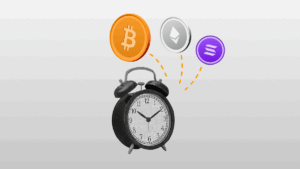
Understanding Solana Staking
Solana staking is a process that allows you to participate in the network’s security mechanism, contributing to its integrity while enjoying monetary rewards. Think of it as earning interest on your savings account, but with the potential for much higher returns. The primary difference? You’re not just saving; you’re helping to secure the Solana blockchain by choosing to stake Solana.
You might wonder how you contribute to network security. It’s through a process called delegation. When you delegate your SOL tokens to a validator, you’re signalling your trust in their ability to confirm transactions on the network. The best part? You still have control over your staked tokens, even as you earn rewards.
Staking SOL offers the following benefits:
There is no minimum amount required to stake.
Rewards start accumulating a few hours to days after initiation.
This flexibility makes it easy for anyone to participate in staking Solana and start receiving staking rewards.
The Role of Validators in Solana
Validators perform a vital function within the Solana network’s Proof-of-Stake consensus mechanism. Validators are network participants who stake their SOL tokens to help validate transactions and create new blocks on the blockchain. The more SOL tokens a validator stakes, the higher their chances of being selected in the PoS process.
The PoS mechanism ensures that as more SOL tokens are staked, it becomes increasingly challenging for malicious actors to gather enough stake to influence consensus, contributing heavily to the security of the network. In essence, validators are the guardians of the Solana network, ensuring that the blockchain runs smoothly and securely.
Validators, in addition to playing a key role in network operations, can potentially earn lucrative staking rewards for their services. It’s a win-win situation – validators help secure the network and get rewarded for their efforts.
Earning Rewards Through Delegated Stake
As a SOL token holder, you can earn rewards by delegating your stake to a validator. This delegation process transfers your stake and voting rights to the validator, demonstrating your trust in their ability to secure the network. Despite this delegation, you retain control over your Solana tokens.
An epoch in the context of blockchain is a set period during which certain actions or events take place. For Solana, an epoch typically lasts about 2.5 days. During this time, the rewards for staked SOL are secured, calculated, and then distributed. This means that every 2.5 days, or every epoch, you have the chance to earn rewards on your staked SOL.
Delegating your SOL tokens offers several benefits:
It earns you rewards
It supports the network’s consensus mechanism
It validates transactions
It strengthens network security
Your stake is a vote of trust; a signal that you believe in the validator’s performance and the network’s potential.
Choosing a Wallet That Supports Staking
Deciding on a wallet that is compatible with SOL staking is an essential part of your staking journey. Wallets like Phantom and Solflare facilitate the direct staking of SOL tokens. These wallets come with different features and security levels, allowing you to pick one that aligns best with your requirements.
Selecting the Right Validator for Your Stake
The selection of the right validator for your stake is as critical as choosing a wallet. It’s crucial to consider the validator’s performance, such as vote reliability and server stability. A validator with poor performance could reduce your staking rewards.
Another factor to consider is the validator’s commission fees on staking rewards. These fees affect your net earnings, so it’s essential to review their commission structures before delegating your stake.
In the spirit of decentralisation, consider staking with smaller operators. This approach can contribute to the Solana network’s decentralisation, a critical health metric for the ecosystem. Resources like solanabeach.io and stakeview.app offer statistics and expected APY calculations to aid in due diligence when selecting a validator.
Initiating Your First Stake
After choosing a wallet, such as Phantom or Solflare, you’re ready to begin staking. Here’s how you can do it:
Staking on Phantom Wallet
First, you’ll need to install the Phantom wallet extension on your browser and create a new wallet.
Transfer your SOL tokens to your Phantom wallet address.
Click on the “Stake” button in your Phantom wallet.
Select a validator from the list provided. Remember, it’s important to research and choose a reliable validator.
Enter the amount of SOL you want to stake and confirm the transaction.
Your SOL tokens are now staked! You’ll start earning rewards after the next epoch.
Staking on Solflare Wallet
- Install the Solflare wallet extension on your browser and create a new wallet.
Transfer your SOL tokens to your Solflare wallet address.
Click on the “Staking” tab on the left side of your Solflare wallet.
Choose a validator from the list. Again, it’s crucial to choose a reliable validator.
Enter the amount of SOL you want to stake and confirm the transaction.
That’s it! Your SOL tokens are now staked, and you’ll start earning rewards after the next epoch.
Remember, once you’ve staked your SOL tokens, staking rewards start accruing. While staking might seem complex at first, it’s a straightforward way to earn passive income and contribute to the security of the Solana network.
Understanding Reward Rate and Inflation Schedule
The reward rate for staking is largely influenced by Solana’s inflation schedule. The inflation schedule, determined by parameters like the initial inflation rate, dis-inflation rate, and long-term inflation rate, is designed to decrease over time. It begins with an initial inflation rate and declines until a long-term stable rate is achieved, annually adjusting the staker reward rate.
The staking yield is primarily determined by the fraction of SOL that is staked on the network. Staking yields are calculated as an annualised number, and they vary each epoch due to fluctuations in the total active stake and the inflation rate.
Understanding the reward rate and inflation schedule can help you strategise your staking investments better. With this knowledge, you can make more informed decisions that can maximise your potential returns from staking SOL.
Keeping Track of the Current Status
Keeping an eye on Solana’s status and updates is more than just a good idea; it’s necessary. Being informed about Solana’s market conditions and updates can help you make timely decisions that can affect your staking returns.
Staking is not a set-and-forget investment. It requires regular monitoring and strategic decision-making. For instance, stakers who persist through market volatility can earn a higher proportion of rewards due to a decrease in active participants.
Furthermore, the Solana Foundation supports the staking community by improving network health and providing validators with new tools. Staying across updates can help you adjust your staking strategy as needed and optimise your returns.
Risks and Considerations in Staking Solana
Despite the potential profits of staking SOL, being aware of the associated risks is crucial. Unstaking SOL is subject to a cool-down period that varies based on network conditions. During this period, the tokens cannot be used for staking or other transactions, which impacts your ability to sell.
Moreover, the value of staked SOL and earned rewards are susceptible to market fluctuations. If the price of SOL decreases, your returns can be substantially affected.
Frequently Asked Questions
What is Solana Staking?
Solana Staking involves locking up SOL tokens to support the Solana blockchain’s validation process and earn rewards for securing the network. It helps ensure smooth validations and contributes to the network’s integrity.
Is Solana worth staking?
Staking Solana provides an opportunity to contribute to the network’s security while potentially earning rewards, with an average annual yield reported to be around 5%. However, it’s important to consider all aspects and risks before making a decision.
How much does Solana staking pay?
Solana staking pays an estimated reward rate of 5.01% annually. However, it’s important to note that this rate is not fixed and can vary based on several factors such as total network stake and inflation rate.
Is there risk to staking Solana?
Yes, there is risk associated with staking Solana. If a validator behaves maliciously, a portion of their delegated stake can be removed and permanently destroyed through a process called “slashing”. Therefore, choosing a secure and reputable staking service and validator is crucial to mitigate this risk. Additionally, if the price of SOL drops significantly, the value of your staked tokens and earned rewards will decrease correspondingly.
Can I lose my staked Solana?
Yes, you can lose your staked Solana through a process called slashing, in which a portion of the stake can be removed and destroyed in response to malicious behaviour. This means there is a risk of losing your tokens if the validator you delegate to acts maliciously.



